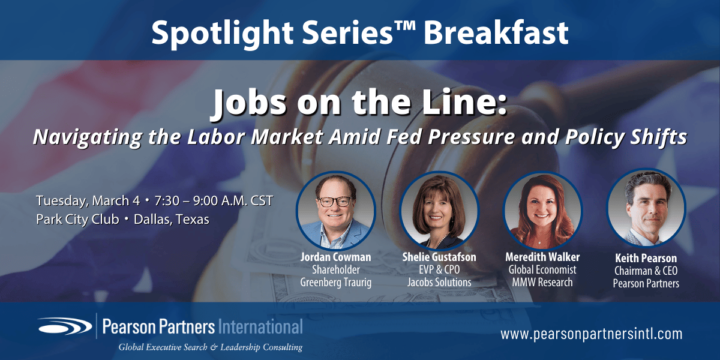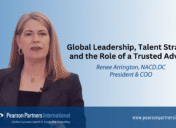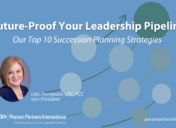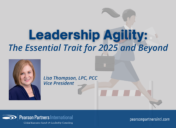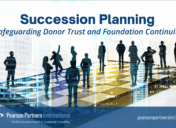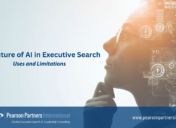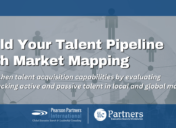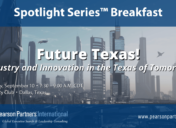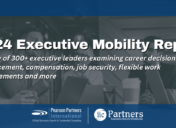Navigating the Labor Market Amid Fed Pressure and Policy Shifts
Dallas-area business leaders gathered recently for Pearson Partners International’s first-quarter Spotlight Series™ breakfast to discuss a topic that has become central to boardroom conversations: the future of the labor market in a time of economic and policy uncertainty.
With layoffs dominating the headlines and shifting public policies impacting everything from trade to immigration, companies are grappling with how to manage talent, develop leaders and navigate unpredictable market dynamics. This candid discussion, led by Pearson Partners’ President and COO Renee Arrington, explored the challenges and opportunities business leaders face in managing their most valuable resource: their people.
A Labor Market in Flux
How do we ensure stability and growth in an environment where so much feels uncertain?
– Renee Arrington, President & COO, Pearson Partners International
In her opening remarks, Arrington noted that the morning’s stormy weather was an apt metaphor for the current labor market—unsettled, shifting and filled with uncertainty. “We’ve seen a lot of changes as we take the business pulse,” she said, citing widespread layoffs in major companies like Amazon, Microsoft, Tesla and Southwest Airlines. Retailers like Jo-Ann and Big Lots are closing stores or scaling down, while others, including Starbucks and Chevron, are tightening their belts in anticipation of more turbulent times.
A panelist later pointed out that while these job cuts are often attributed to economic headwinds, the root causes remain complex and multifaceted. Factors such as immigration policy, global trade disruptions and evolving labor market expectations all play a role.
Policy Shifts and Business Implications
One of the most pressing issues discussed was the impact of recent federal policy shifts, as the newly formed Department of Government Efficiency (DOGE) and new tariff initiatives send ripple effects through multiple sectors.
A panelist with deep experience in international labor law noted that the DOGE initiative is prompting public agencies and private companies to conduct similarly fashioned internal audits to eliminate inefficiencies and redundancies. “States are following suit,” said the panelist, with several launching reviews focused on rooting out bloat and fraud.
While these efforts may lead to greater efficiency, they are also triggering mass layoffs within government agencies. These layoffs are impacting services that businesses depend on, creating bottlenecks and delays in areas like immigration processing and regulatory approvals.
On the trade front, the conversation centered on the administration’s tariff policies. A panelist remarked that while tariffs were once thought to be merely a negotiating tactic, they are now being implemented in full, driving up costs on raw materials and imported goods. For example, produce and automotive parts sourced from Mexico and Canada are already seeing price increases due to steep tariffs. These pressures are fueling concerns about inflation and creating additional costs for manufacturers and retailers.
“Bringing jobs back to the U.S. is part of the strategy,” noted one panelist, “but it’s also driving wage inflation as companies compete for workers to fill these new roles.”
At the same time, the tariffs are designed to incentivize domestic job creation. However, one panelist noted that tariffs and immigration policy might work together to increase labor costs—especially in comparatively lower-wage industries like agriculture, construction and manufacturing.
Remote Work, Return-to-Office Mandates and Company Culture
Another focal point of the conversation was the ongoing challenge of managing the return to the office. Some organizations are finding that a hybrid workforce complicates efforts to foster collaboration, innovation and a cohesive company culture.
As one panelist noted, companies that require employees to be in the office two or three days per week are seeing mixed results. In some cases, leaders are concerned that employees return only to spend their time on video calls, defeating the purpose of in-person collaboration.
“We can’t ask people to come in just to sit in virtual meetings,” a panelist emphasized. “We need intentionality—planned collaboration, problem-solving sessions and team-building initiatives.”
Another panelist quipped that it’s time to “make offices great again,” highlighting the need to create spaces where employees want to work, not just where they are required to be. The panelist cited in-person interactions, serendipitous conversations and informal mentoring opportunities as key benefits of being on-site—benefits that are hard to replicate in a fully remote environment.
Leadership Development and Succession Planning
The conversation also explored the challenges of developing the next generation of leaders, particularly middle managers who often bear the brunt of organizational change. Several panelists observed that management roles have become less attractive to employees who see leadership as fraught with stress, complex responsibilities and limited rewards.
One panelist suggested that companies need to “make management cool again,” focusing on the intrinsic rewards of leadership and reinforcing the value of mentoring and developing others. Financial incentives are part of the equation, but personal fulfillment and a sense of purpose are equally important.
Another panelist noted that veterans bring valuable leadership experience and resilience, making them ideal candidates for middle management roles. Companies that actively recruit and support veterans are benefiting from their ability to lead teams through complex and challenging environments.
Panelists also discussed the resurgence of corporate universities and internal leadership programs. One example shared was a global organization that partnered with an executive education provider to create a customized culture alignment and leadership development initiative. While some companies have moved away from traditional corporate universities due to cost concerns, others are finding that targeted, scalable programs—often delivered in hybrid formats—can effectively prepare future leaders.
Technology’s Expanding Role in Talent Management
The panel also addressed the role of technology—particularly artificial intelligence (AI)—in transforming workforce management. One panelist pointed out that AI tools are being used in the legal profession to automate document drafting and case research. While these technologies can enhance efficiency, they also raise legal and ethical questions—particularly in recruitment, where AI-driven systems may inadvertently introduce bias. The takeaway? Embrace AI, but do so with caution and oversight.
Another example highlighted the concept of “hybrid intelligence,” where AI works alongside human expertise to improve decision-making and productivity. In the context of talent management, leaders must ensure their teams are trained to leverage technology effectively, starting with leadership and cascading throughout the organization.
“Some people fear that AI will take their jobs,” one speaker noted. “But in fact, the jobs that AI will replace are those of people who don’t know how to use it.”
Generational Shifts and Labor Market Expectations
The panel also addressed the growing complexity of managing a multigenerational workforce. With five generations now working side by side, leaders must navigate differing values, motivators, expectations and communication styles.
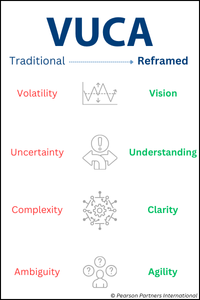 One panelist shared how business leaders are reframing the traditional VUCA model (volatility, uncertainty, complexity, ambiguity) into a more positive framework: vision, understanding, clarity, agility.
One panelist shared how business leaders are reframing the traditional VUCA model (volatility, uncertainty, complexity, ambiguity) into a more positive framework: vision, understanding, clarity, agility.
This forward-thinking mindset can help leaders and organizations focus on long-term purpose while remaining flexible in the face of ongoing change.
Inflation and Economic Predictions
As the discussion concluded, Pearson Partners Advisor Dr. Robert Potter posed a question to the room: Where are prices headed in the next year? Almost all the panelists and audience predicted that inflation would continue to rise, citing factors such as wage pressures, tariffs and immigration constraints.
However, a few attendees offered a more optimistic view, suggesting that increased efficiency and technological advancements could help stabilize prices over time.
A Time for Thoughtful Leadership
In his closing remarks, Keith Pearson, Chairman and CEO of Pearson Partners International, acknowledged the importance of navigating this challenging environment with clarity and collaboration.
We need to be intentional about how we lead—whether in our approach to developing talent, managing change or building partnerships across industries.
– Keith Pearson, Chairman and CEO, Pearson Partners International
Arrington agreed, emphasizing that while uncertainty is a given, business leaders can make a difference by fostering a sense of purpose and connection within their organizations.
We have done this before. We managed through COVID. We adapted. We innovated. And we can do it again.
– Renee Arrington, President & COO, Pearson Partners International
As always, Pearson Partners International remains committed to helping executives and organizations navigate these complex dynamics through its quarterly Spotlight Series™ events—continuing the conversation on leadership, strategy and the future of work.
Learn more about the Pearson Partners Spotlight Series™ breakfast events.
Related Posts
- ← The Cost of Corporate Neutrality: Insights from the Q4 2024 Pearson Partners Spotlight Series Breakfast
- The Future of AI in Executive Search →

